Tears of the Prophets has a number of very good ideas.
The character arc driving the episode is very good, particularly in the context of a finale leading into the final season of the show. Star Trek: Deep Space Nine has always been a show more interested in character arcs and long-form storytelling than the other Star Trek shows, so “Benjamin Sisko experiences a loss so great that he resigns his commission” is an organic story beat. It feels like a story that the writers on this show can tell, and a story that fits very comfortably within the grand mythic framework that the writers are trying to construct.

All fired up.
Unfortunately, Tears of the Prophets is compromised by a number of very poor ideas. Some of those ideas did not originate with the writing staff, their hands forced by outside factors. Ira Steven Behr’s original plans for Tears of the Prophets did not include the death of Jadzia Dax, but the writers had to incorporate that plot element rather late in the cycle. Of course, this does not excuse some of the poor decisions made in how the writers chose to handle that unforeseen plot element, although that was also a result of a number of outside factors.

So Jad to zia you.
The result is a somewhat uneven episode, a story with a very strong central character arc that plays to the strengths of the show, but with several supporting elements that indulge the series’ worst impulses.

Funeral for a friend.
The writers working on the sixth season did not realise that Terry Farrell was leaving until quite late in the production process. The bulk of the cast were in the process of renegotiating their contracts for the final season, and the prevailing attitude was that Farrell’s reluctance to sign was a negotiating position. Ronald D. Moore acknowledged as much in hindsight:
There were a few scares about Patrick leaving at certain points, weren’t there?
We heard that almost every year, and we always sort of wrote it off as a contract thing. We never took it seriously. To our detriment, ultimately, because when Terry Farrell said she was leaving we didn’t take it seriously either! “Oh, they all say that. They all come back.”
But not that time…
Not that time.
To be fair, this is par for the course in television production. Actors sign contracts at the start of a show’s run, usually at competitive rates. However, if the show is successful enough to last past the length of that initial contract, the actor then enjoys substantial leverage. Playing an established character on a successful show allows an actor to set their own terms at renegotiation time; David Duchovny would take advantage of this on The X-Files.
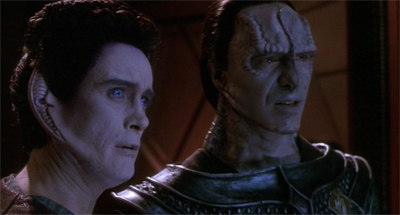
Don’t Damar his name.
As such, the sixth season was never intended to culminate in the death of Jadzia Dax. The writers would likely have made a number of very different storytelling decisions had they known that Terry Farrell would be leaving the series. Ronald D. Moore has insisted that they never would have married Dax and Worf in You Are Cordially Invited…, while it seems likely that the producers might have gone a different direction with Change of Heart. Tellingly, late season episodes like Valiant or The Sound of Her Voice tend to write around Dax rather than for her, relegating her to small roles.
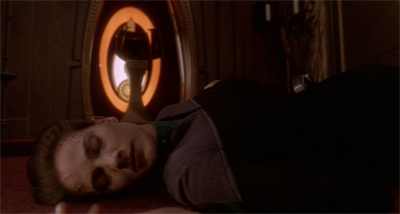
Dying to leave the show.
“I knew they wouldn’t say you don’t have to show up until 9 a.m. – although that would’ve been delicious, no more 4 a.m. wakeups,” she said. “However, I did suggest in the wake of that I could be recurring… not be in every episode. Rick wouldn’t have any of that. It was basically, ‘Here’s the offer. If you want it, sign it. If you don’t, it’s really been nice working with you.’ I went with ‘It’s really been nice working with you’ – I added that because it really sounds nicer. I don’t think Rick was thinking that at all. That was unfortunate.”
Farrell continued: “After Jeri Ryan (Seven of Nine on Star Trek: Voyager) and I were on the cover of TV Guide, I got a call to come in and audition for a Jerry Seinfeld show. I couldn’t even go in and audition for it because Rick wouldn’t let me out for the week. It’s a week! It’s five days! How many people are on DS9? There’s a lot. I could be in 10 episodes and could still do voiceovers on comp. The truth is there’s many episodes where all of us had very little to do because other people were starring in them, including recurring guest-stars like (Andrew J.Robinson, who played Garak) who should’ve just been a regular. With that combined, knowing that other actors – and no harm to them; it’s great that they got the deal where they could go out and do stuff – but knowing that was possible, it wasn’t being made possible for me. I was only asking for five days, not five weeks.”
Farrell’s argument is reasonable on a number of levels. Weekly television places a phenomenal pressure upon an actor. Actors tend to start early and finish late, always required to give their all, even at the point of exhaustion. On Star Trek, these demands even include prosthetics and costuming.

Baby not-on-board-yet.
More than that, modern television increasingly blurs the line between regular and recurring cast members. For example, despite being credited as a guest star, John Slattery appeared in more episodes of the first two seasons of Mad Men than series regular Vincent Kartheiser. Indeed, it could reasonably be argued that the biggest divide between a regular cast member and a recurring player is purely economic, with modern television slashing the salaries of even prominent guest stars.

Who Prophets?
This supporting cast was robust enough that entire episodes could sideline the majority of the credited regulars. Soldiers of the Empire took place primarily on General Martok’s ship, with a mostly Klingon cast. The Magnificent Ferengi could draw together a collection of Ferengi guest stars for a wacky adventure with Iggy Pop. Honour Among Thieves could focus on O’Brien working undercover, relegating the bulk of the primary cast to a quick appearance after the opening credits. Even Valiant hinged on Jake and Nog, neither appearing in the majority of Deep Space Nine episodes.
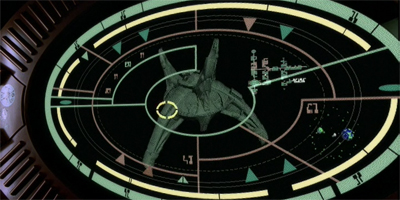
A solid platform to build upon.
As such, it seems unlikely that Deep Space Nine would have been able to support demoting Jadzia Dax to a recurring character in the same way that a modern television series would simply sideline an actor asking for more personal time. Even if it were possible, it seems highly unlikely that the senior producers would have allowed it. Wil Wheaton has talked quite a bit about the difficulty of trying to negotiate such compromises with producer Rick Berman, and how difficult he made life for his cast members. (And how he punished those who wanted to leave.)

Sometimes working on Star Trek was not a Paldor Joy.
The problems with my leaving were with Rick Berman. In my opinion, he’s just very misogynistic. He’d comment on your bra size not being voluptuous. His secretary had a 36C or something like that, and he would say, “Well, you’re just, like, flat. Look at Christine over there. She has the perfect breasts right there.” That’s the kind of conversation he would have in front of you. I had to have fittings for Dax to have larger breasts. I think it was double-D or something. I went to see a woman who fits bras for women who need mastectomies; I had to have that fitting. And then I had to go into his office. Michael Piller didn’t care about those things, so he wasn’t there when you were having all of these crazy fittings with Rick Berman criticizing your hair or how big your breasts were or weren’t. That stuff was so intense, especially the first couple of years.
I started modeling when I was seventeen, so I was used to comments like that, but it was a different experience for me to be around normal, respectful people. And then he’s my boss.
Farrell’s account of the dynamic is consistent with other accounts of Berman’s managerial style, his tendency to undermine and undercut those who work underneath him. Bryan Fuller would note a similar dynamic when Ronald D. Moore (briefly) joined Brannon Braga on Voyager.
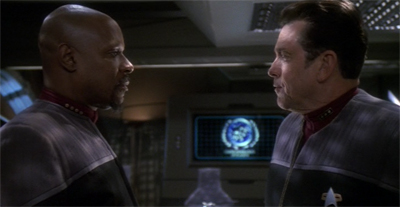
Not somebody that you want to Ross.
To be fair, Farrell does not seem to bare any ill will towards her history with the Star Trek franchise. She does not appear to resent her time on Deep Space Nine. Farrell enjoyed a prominent role on Becker for years following her departure, sharing the screen with sitcom legend Ted Danson. She still attends conventions, and still talks fondly of her time on the series. She is one of the few regular cast members to be actively participating in Ira Steven Behr’s Deep Space Nine documentary.
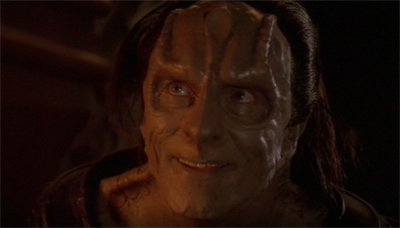
Oh, your gods…
Let’s put it this way: if I had known what was going on, I would have stopped it. There is no doubt in my mind, because that opened a whole can of worms, and I learned more than I wanted to know what was happening under my nose and behind my back of things that were going on. I would have walked over to the Cooper Building and in one conversation I would have stopped that from happening, but everyone chose not to tell me for various reasons. Including, as I found out, to protect me from having to get in someone’s face and what that would mean for my position and stuff like that. And I said that was all ridiculous.
It should be noted that the production team were careful to do right by Farrell. Once it became clear that Farrell would not be sticking around, the writers made an effort to downplay the character’s role and afford Farrell time to audition for other shows. This is why she barely features in The Sound of Her Voice.

Having faith in each other.
There are various ways of writing a character out of a show. The Next Generation was generally rather professional in how it handled these departures; Tasha Yar died suddenly in Skin of Evil, but the rest of the departures were all framed as work transfers. Beverly Crusher went to Starfleet Medical and them came back. Katherine Pulaski was there for Shades of Grey and gone in Evolution without anyone batting an eye. Wesley Crusher finally left to attend Starfleet Academy in Final Mission. There was some sense of professional mobility on the Enterprise.

The Martok to war…
Transferring Dax would’ve meant transferring Worf as well, and we weren’t going to do that. It also would’ve meant that everyone would be waiting for a Dax guest shot all year and our characters would’ve been talking about her all season (especially Sisko, who would’ve presumably kept touch with the Old Man wherever s/he was). We didn’t want Terry to go, but once she made the decision, we felt it was in the best interests of the show to kill Jadzia and start next season with a new regular who would be the next incarnation of Dax.
Moore has something of a point here. It would be very hard to explain what Worf was still doing on Deep Space Nine, or why the characters weren’t constantly talking about Dax.
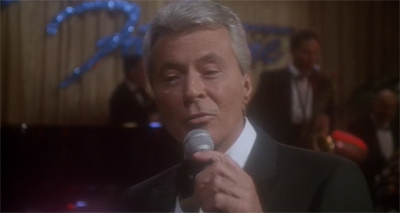
Sing when you’re winning.
It is easy to imagine a similar issue writing around the absence of Jadzia Dax. What could the writers do? Transfer her to another post, perhaps as a way to prevent a repeat of Change of Heart? That would likely mean that Sisko and Worf would be constantly talking about off-screen communication with the character. Have her sent behind enemy lines or captured by the Dominion? The audience would wonder why Sisko and Worf weren’t doing everything in their power to bring her home safely every episode.

Bashful Bashir.
However, Jadzia was always comfortable in her own skin. As a result, many of the stories about Jadzia tended to treat the symbiont as a plot point, a vehicle to tell stories that didn’t afford Dax a lot of agency herself; Dax, Invasive Procedures, Blood Oath. Killing off the character of Jadzia raised the question of what would happen to Dax. Quite pointedly, even before the writers knew what they were going to do with the symbiont, they make a point to have Bashir assure the audience that the symbiont is alive. A new host opens up new storytelling opportunities.

Romulus wasn’t built in a day…
However, Terry Farrell’s departure had blindsided the production team. There was no proper opportunity to set up or foreshadow her departure, barring some ominous framing during O’Brien’s eulogy for Lisa Cusak in The Sound of Her Voice and some mean-spirited teasing of a future that could never be in Time’s Orphan. There was a sense that the sixth season finale would have to be about the death of Jadzia Dax, on top of all the other things that the production team had planned for it to be about. There was not avoiding this fact.

“Sorry, I came straight here from the David Cronenberg festival.”
“I didn’t want to kill Jadzia,” says Deep Space Nine’s Executive Producer Ira Steven Behr. “To me that has very little to do with good storytelling.” It’s not, he explains, a matter as clear-cut as giving a character like Hamlet a good death in his one play. “It’s like Hamlet’s been in one hundred fifty plays,” says Behr. “This is the final play. And you have all this baggage that you don’t need to have. It can’t be ‘What’s good for the character.’ It’s ‘What’s good for the character in terms of the character’s position on the show, her position with the fans, what the fans want to see.’ None of that has to do with what makes a good episode.”
Behr is correct in this. The death of Jadzia Dax becomes a centre of gravity, warping the episode around it.
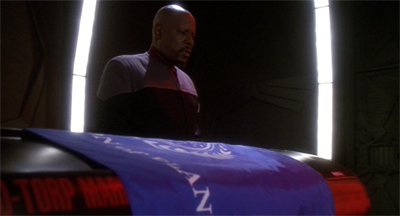
“You have been, and always shall be, my friend.”
J. Michael Straczynski faced this issue a number of times on Babylon 5, a show with a much tighter long-form story than Deep Space Nine. Straczynski famously mapped out the entire run of the series, plotting it as a “novel for television.” However, Straczynski was also cognisant of the fact that there were outside factors at play. Specifically citing the risks involved with hiring actors, he assured fans that he had cannily built “trap doors” into the plot to compensate for any unscheduled departures. Still, Straczynski was caught off guard by some key casting shifts.

Who says romance is dead?
For reasons that are entirely understandable, the production team chose not to abandon their preexisting plans. The death of Jadzia Dax would not be the primary focus of Tears of the Prophets. Instead, it would be incorporated into the tragic fall of Captain Benjamin Lafayette Sisko. This was a risky proposition, particularly given that the structuring of the episode could make it look like “fridging”, as though a major female character were being killed off to further the arc of the male characters around her.

“Burn with me.”
Still, the writers knew from early on that Tears of the Prophets would not really be about Jadzia. However, this creates an interesting conflict within the episode, as though the writers are caught between two extremes. On the one hand, the writers clearly want to portray Jadzia’s death as just something that happens, something that is intentionally meaningless and arbitrary, underscoring the chaotic nature of the universe at large. On the other hand, they also want to ensure that the death is both memorable and respectful.
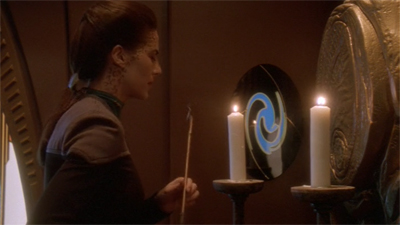
“Ezri won’t hold a candle to me.”
“I beg you to consider the following, and I’ve never been as sure of anything in my life. Let Dax live a little longer. Keep your audience interested in her survival, rather than losing the tension by having her die in the fourth act. The battle raging and the Orbs failing will not have nearly as much audience interest as Dax’s survival. You don’t have to do any dialogue with her, although a couple of words may be touching.”
Although Piller had left Voyager under very unpleasant circumstances, he was still held in relatively high esteem by the writers on Deep Space Nine. More to the point, Piller was making a reasonable observation. There were a lot of fans out there who would want the death of Jadzia Dax to be meaningful and to receive all the dramatic weight afforded to that of Spock in Star Trek II: The Wrath of Khan.
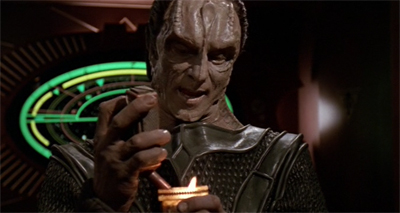
Dukat lightens the mood.
Indeed, this baby subplot winds up getting Jadzia killed. When the initial test results are positive, Jadzia decides to visit the Bajoran shrine to pay homage to the Prophets. This is obviously designed to play as dramatic irony. After all, Jadzia is one of the more staunchly atheist members of the primary cast, as demonstrated by her attitude in The Reckoning. Even in prayer in Tears of the Prophets, she concedes, “To be perfectly honest, I feel more comfortable thinking of you as wormhole aliens.” So to have her brutally murdered while visiting a religious shrine is a very cruel twist.
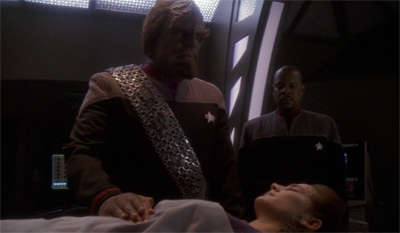
Losing one’s wife.
To be fair, Ronald D. Moore has argued that Jadzia remained on the station because of the decision made at the end of Change of Heart that she should no longer be assigned to missions with Worf. This makes a certain amount of sense, and also conveniently explains her absence from the Defiant in The Sound of Her Voice or Valiant. Still, this seems somewhat impractical for two senior staff members working on the same outpost. Surely this is not an issue in cases where both Worf and Dax would be working under Sisko’s command, rather than autonomously?
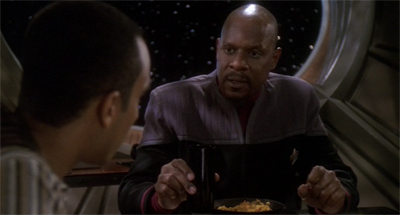
Sisko chews it over.
All of this rather blatant foreshadowing undercuts the supposedly random and arbitrary nature of the character’s demise. After all, Dax is ambushed by Dukat on the station at a point in time when Sisko is leading a dangerous invasion of Cardassian space. There is an interesting reversal of expectations there, one somewhat undercut by the awkwardness with which the series manoeuvres Dax into position. Similarly, Dukat’s murder of Dax is clearly intended to be casual. It is not his goal or motivation, she just got in the way. But that is undercut by the attention that the episode pays to her.

Klingon to life.
I fought pretty hard to not have Dax die the way she did. I wanted to lose the character in a way that was a gut punch. I wanted Dukat to execute her, but instead he beams into that place to get the Ark of the Orb, and she surprises him or something and gets the drop on him. But the idea in the original was that she somehow stumbled across it, or was in the wrong place at the wrong time, and Dukat got her. He just f%$king executes her. And it was brutal, and it was supposed to be shocking. It was supposed to really hit you, and Rick Berman adamantly refused. He just would not let us do it. “She’s got to fire a shot, and she has to die shooting at him. She has to die in a heroic way.” And I was just, like, “Come on.” I don’t think it works the way it is. It’s flat.
Moore makes a pretty solid argument, even if he fudges some of the details when describing the version that made it screen.

“What’s this? It’s my character ark.”
This sense of compromise is perhaps most apparent in the decision to keep Jadzia alive just long enough for Worf to say goodbye. The scene is very awkwardly balancing on a razor edge. On the one hand, it is a compassionate gesture to both Worf and to the fans, allowing one last glimpse of Terry Farrell before consigning the character to a torpedo. However, it is somewhat undercut by having her last line concern the baby that was barely set up in Times Orphan and only really discussed at the start of Tears of the Prophets.
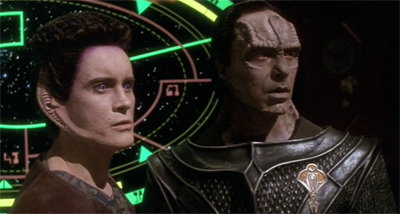
Meanwhile, on Cardassia…
The result is a sequence that feels muddled, the result of countless different creative voices struggling to reach a compromise that satisfies nobody. The sequence suggests that there is some small measure of compassion in the universe, affording the audience one last chance to spend time with Dax and preventing her final word from being “Dukat!”, but it is slotted awkwardly into what is clearly intended to be a much more sombre piece of television. The result is a scene that plays like television cliché, but without any of the benefits that usually accrue from clichés.
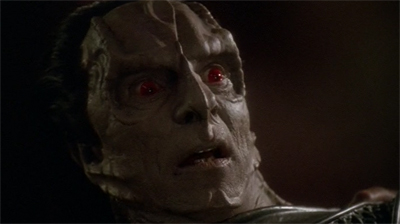
Dukat took the red eye…
The decision to add a final scene for Jadzia, allowing her to live long enough to say goodbye to Worf, was an important one. Beimler admits that he was a little worried about it. “I was afraid that we wouldn’t do it justice,” he says.
And Behr was on the fence. “There was never a total consensus among the writers,” he says, “but one of René Echevarria’s reasons for existence is because he tends to speak to the softer, gentler side of our natures, and he felt he needed to see her die.”
Indeed, Action! explores some of the logistical difficulties posed by the relatively late addition of the scene to the script.

“This cocktail is made from Klingon tears.”
These problems are compounded by some unforced errors, particularly the decision to anchor Gul Dukat to the Pah-Wraiths. Once again, it feels like the writers are looking towards the end of the series. On a purely thematic level, it makes sense for Dukat to position himself as “the Emissary of the Pah-Wraiths” to lend some symmetry to his inevitably throwdown with Sisko in What You Leave Behind. More pragmatically, heading into the final season, it made sense to combine the show’s various plot threads, streamlining the longform narrative.
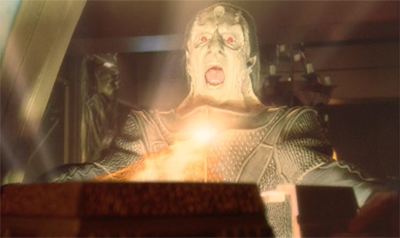
Dukat speaks from the heart.
There is not necessarily anything wrong with Waltz. It makes a valid argument about Dukat, and very strongly rules out any redemptive reading of his character. However, the problem with this creative decision was that it left very few avenues open to the production team. There was really nowhere that Dukat could go from that episode. His twisted soul had been exposed to the universe, and he had explicitly acknowledged the monstrous impulses that he had kept buried for so long. Waltz would have been a fantastic swansong for the character.

“For some reason, Captain Sisko hasn’t found much occasion to speak to me lately.”
While Marc Alaimo is having great fun with the role, the dialogue feels like it was written for a comic book supervillain. “I’m a new man,” he assures Damar and Weyoun. “I no longer have a need for conquest or power. I’m far beyond all that. I exist in a state of complete clarity. A clarity I intend to share with the universe.” That is not something that healthy characters say. As Weyoun notes, “You’ve gone from being a self important egotist to a self deluded madman. I hardly call that an improvement.” He’s right. Dukat has been diminished.
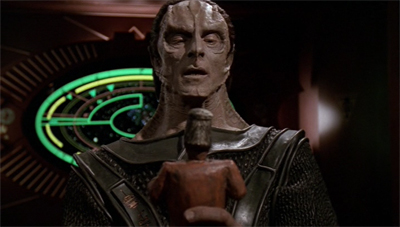
False prophets.
It is a creative decision that undercuts a lot of what is so compelling and so effective about Deep Space Nine. Although Deep Space Nine has always had a very strong moral compass, but it has also been more willing to acknowledge that individuals are not purely good or purely evil. Episodes like Defiant suggested that even a mass murderer like Dukat was capable of loving his children, while episodes like In the Pale Moonlight suggested that even Sisko would be willing to compromise his morality for the right price.
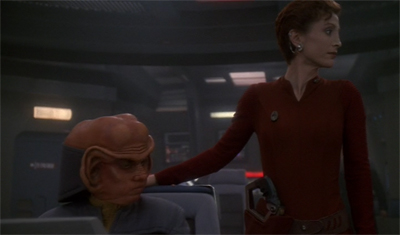
A bridge too far…
Combining Dukat and Pah-Wraiths brings out the worst aspects in both story threads. Wedding the Pah-Wraiths to Dukat affirms his status this monolithic “big bad”, the dragon waiting at the end of the story to be slain by Sisko, rather than existing as a character with his own distinct personality and agency. Wedding Dukat to the Pah-Wraiths affirms their importance to the narrative, asserting that these relatively late additions to the mythos are important by anchoring them to a character who has been around since the very first episode.
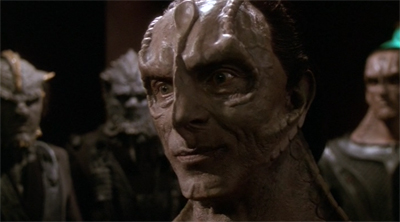
The Pah-Wrath of Khan.
Indeed, Tears of the Prophets marks the perfect opportunity to check back in on the larger war arc. Although the Romulans were mentioned in passing during the briefing at the start of The Reckoning, this is the first time that they have appeared in an episode since joining the war effort in In the Pale Moonlight. Although suitably smug, Letant ultimately joins the ranks of “one-shot Romulan guest stars” like T’Rul from The Search, Part I and The Search, Part II. Even when the seventh season lands a recurring Romulan character, she is played by two different actors.
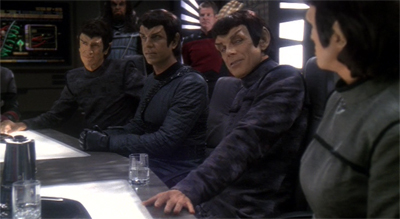
“Yep. Still rockin’ shoulder pads.”
Although Damar and Weyoun are largely passive in terms of plot, whether providing the audience with exposition or Dukat with a plot device, the pair play very well off one another. In particular, the two actors do a lot of great work during their scenes with Dukat. When Dukat appears, Jeffrey Combs plays Weyoun as borderline contemptuous, no longer bound to the displays of courtesy that he afford Dukat as leader of Cardassia. In contrast, Biggs plays Damar as genuinely conflicted. He is clearly in awe of Dukat, and genuinely concerned about his psychosis.
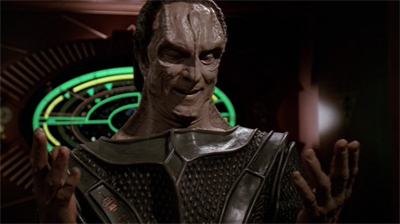
Admiring his handiwork.
How brilliant Ira Behr was: he got a stable of writers who were all anarchists and he loved the concept of repertoire-ing. Jeff and I were never regulars, but we were as intrinsically important to that storyline as the regulars were.
There were swathes of episodes where the series regulars were home by the pool.
It was, like, our show.
And that’s unheard of. If they hadn’t been busy with Voyager and launching another Next Generation movie, if their energies hadn’t been out there, they probably would have said, “No, no, no, you can’t do that. We have series regulars, you have to use them.” But Ira was a magician.
The writers really liked Jeffrey, and when they killed him off, they said, “Well, sh!t, let’s replicate him. Clone him!”
That idea started as a problem solve. “Well, sh!t, we killed that character. Why did we do that?” And then they saw the dailies, and then someone said, “We can clone him,” and it became a recurring joke.
They finally gave Damar a sense of humour, which was great. They knew they needed a foil for Dukat and they saw how Jeffrey and I worked together and built on that.
They really were shooting from the hip a lot of the time. They had a sort of a plan of storylines, but then a lot of the time they would watch dailies and get ideas from what we were bringing to it. And the next episode we could have these two guys do something else.
The tension between our characters was great. They’d stick us in the room, and he and I are like in a f%$king candy store together when we’re playing, and it just works. They liked the way I looked sitting in Quark’s bar, and I became a drunk for two years after that. But that’s why those writers were so good. Speaking of that, because as a recurring role you don’t know how many episodes they have in mind for you, I got a show on Broadway. Ira said, “What are you doing? We’ve got you scheduled for twelve more episodes.” I said, “You didn’t tell me that!” You know what they did? They flew me back on my day off and kept our storyline going.
These details illustrate that Deep Space Nine might easily have been able to rotate Terry Farrell into the broader ensemble, if the framework were there in nineties television. The willingness to treat recurring guest stars like cast members, to check in on them as part of “event” episodes and just because, really sets Deep Space Nine apart.

Oh dear, Odo.
To be fair, not all of these beats are ideal. There is a weird little subplot focusing on Bashir and Quark, in which the pair react with depression to the news that Jadzia is planning to have a baby with Worf. “A baby,” Bashir reflects. “Do you have any idea what that means?” Quark acknowledges, “That their marriage is going to last a lot longer than we thought.” In other words, Bashir and Quark have both been secretly pining for Jadzia for years, a detail that the writers had introduced into subplots in Change of Heart and Valiant.

“Don’t worry. I’m sure at least one of us will end up with a consolation prize.”
We loved the Vic scene and its associated storyline of Quark and Bashir trying to get over the loss of Dax. Bashir and Quark begin the episode by mourning their own loss of the character and trying to come to grips with the finality of that loss which in turn perfectly foreshadowed the actual death of Dax herself at the end.
Structurally, Moore has a very reasonable point. However, the subplot still feels ill-judged.

Tabling the debate for later.
However, there is also something unsatisfactory in the implied connection between Bashir and Quark mourning their “loss” of the chance of a romantic relationship with Dax to the actual material loss of Dax. Bashir and Quark are holding a preemptive wake for their romanticised fantasy of Dax, which feels somewhat distasteful in the context of an episode that builds to the climax of Benjamin Sisko painfully monologuing over the corpse of his best friend. Still, the subplot featuring Bashir and Quark is something of an outlier in the episode’s quick run-through of the cast.
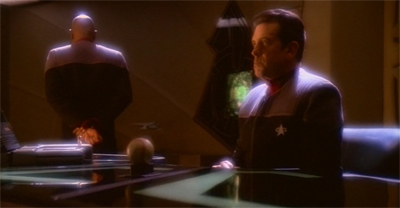
Prophets and Loss…
Sisko has come a long way since the disillusioned commander on the verge of resignation in Emissary; he has grown to accept the role of Emissary over the past six seasons, and come to embrace his position as a very important Starfleet officer. Sisko has healed and grown over these years. More than any other Star Trek lead, with the possible exception of the version of Kirk appearing in the feature films, Sisko has a very clear arc that evolves in a (relatively) logical manner across the run of the series.
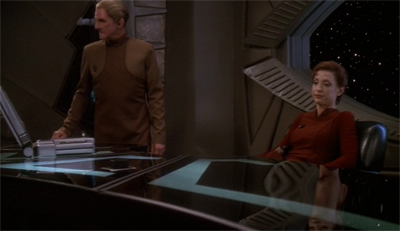
Sisko refuses to play ball.
Sisko’s crisis of faith at the end of Tears of the Prophets is an extension of this idea. It is perfect character beat for a penultimate season finale, effectively forcing Sisko to confront (and restore) his beliefs before embarking on the final leg of his journey. It also provides a very effective contrast with the sprawling galactic politics of Call to Arms. The fifth season finale threw an entire quadrant into chaos, casting doubt upon the future of the entire Federation. While Tears of the Prophets cuts off Bajor from the Prophets, it suggests much more personal stakes.
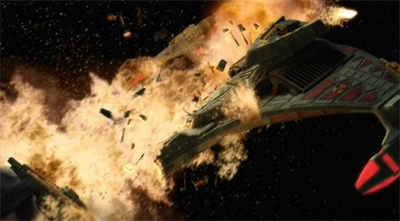
Everything burns.
The sixth season of Deep Space Nine had opened big, but had struggled to find a proper direction when it emerged from that phenomenal six-episode stretch. The ending to Tears of the Prophets suggest that the production team have decided to reverse that approach going into the seventh season. The seventh season of Deep Space Nine opens with a much quieter and low-key two-parter, before building to a massive ten-part series finale that wraps up most of the dangling loose ends from the seven-year run.
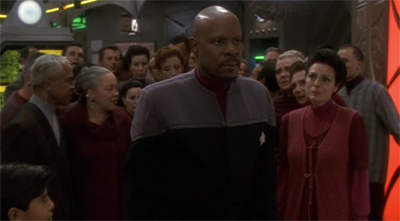
“In hindsight, I probably should have let Akorem Laan keep the job.”
Tears of the Prophets opens with Sisko at one of the highest points of his career, receiving “the Christopher Pike Medal of Valour” and spearheading the Federation invasion of Cardassian space. However, it closes with all of that lost. Sisko is a broken man, somebody lost and without purpose. He is a kitchen hand working in his father’s restaurant. More than that, this is where he has chosen to be. It is not as though Sisko is trying to overcome a change in circumstances. Sisko is instead wrestling with his own self-doubt.

Scrub this from his record.
Filed under: Deep Space Nine | Tagged: arcs, Benjamin Sisko, death, deep space nine, ds9, Jadzia Dax, plotting, Prophets, religion, star trek, tears of the prophets, the reckoning |




















I didn’t like the way Jadzia met her end in this episode. I think she deserved to go out in a real heroic way. What happens to her here feels like it was put together on the spur of the moment and I think it shows too. I also wished that the ending was longer and we had more scenes of the rest of the crew dealing with her loss in the immediate aftermath. Jadzia is one of my favourite characters in all of Star Trek. I missed her very much in season 7.
I think the seventh season handled the aftermath of her death quite well. But yeah, Tears of the Prophets botches her death through a series of false compromises. It is either a meaningless death or a meaningful death, but the episode tries to have it both ways and so satisfies no one.
I agree that the long term aftermath was well handled, but the way she met her end was very poor.
Definitely.
Darren, this was another good, insightful review.
I am really looking forward to your write-ups on Season Seven. I never saw it when it first aired, except for the series finale, because I was out of the country from Oct 1998 to May 1999. After all these years I’m watching all those episodes on Netflix. There’s some interesting, quality stuff, and I’m anticipating reading your thoughts on those episodes.
Thanks Ben. I hope I can live up to that.
On an admittedly childish note, I thought battle scenes in this episode were probably the series. While the size of the opposing forces didn’t feel quite as large as “Sacrifice of Angels”, the various ship and weapon platforms blasting one another was quite impressive. We got a bit of a taste again in “Once More Unto the Breach”, but a major battle wouldn’t occur again until “What You Leave Behind”, which was kind of spoiled for me through the excessive use of stock footage from other episodes.
Speaking of the battle, I’ve never heard a satisfactory explanation for why Kira assumes command when Sisko tags out, rather than Worf. Worf, of course, had explicitly been cited as first officer of the Defiant, and frequently commanded it in Sisko’s absence (such as in “Paradise Lost”). In retrospect, it’s satisfying seeing Worf move up in the ranks like this, since we almost NEVER saw him in command on the bridge of the Enterprise. This effective demotion is never explained (though I’ve heard people cite the events “Change of Heart” as a reason).
Frankly, the show has often been rather arbitrary about who does what on the Defiant. (Nog essentially inherited the helm from Jadzia after her death, but for some reason, Kira sits there for the Defiant’s last stand in “Changing Face…”
In fact, I’ve heard fans question whether a non-Starfleet officer like Kira has any business on the bridge of the Defiant at all, let alone commanding it. (Do Bajoran terrorism and Cardassian space stations prepare you for starship operations?) At least they wisely didn’t put Odo on the ship (which would’ve made even less sense) most of the time. (There’s absolutely no reason for Odo to be on the ship, for instance, in “The Adversary” or “What You Leave Behind”)
There’s a whole host of hazy logic around the command structure of DS9 and the Defiant.
In particular, there’s something very awkward in the way that Ross just gives the Romulans a base on the station in Image in the Sand. Deep Space Nine is a Bajoran station, something reinforced as recently as Kira’s protest to Sisko in Call to Arms. It could easily have been fixed with a handwave of “the Provisional Government’s already signed of on this…”, but it does feel like Starfleet Command is now running the shots.
The big death is probably the biggest problem with this finale, along with the pah-wraith stuff, which is straight out of a bad fantasy novel. The reasons why it doesn’t work are simple-it pretty much stands in contrast to everything DS9 was trying to achieve-it fails to enrich or bring nuance to the Trek universe-in fact it does the opposite, simplifying a fascinating concept (the non-linear beings from Emissary, a brilliant concept worthy of the best tv science fiction franchise of all time) and fascinating characters (such as Dukat and Winn). Overall, the whole concept and storyline is just a misfire.
Jadzia’s death is slightly more complicated. For one thing, it just doesn’t feel right that a Star Trek show would kill off a series regular. It doesn’t fit with the tone of DS9-for all that it has a reputation of being dark, it was quite generous with its characters’ fates. I think you could characterize the majority of them as happy endings. For that reason, even if the death was executed flawlessly, I don’t think it would have as much of an impact on me as on other shows. It’s too obviously forced by outside circumstances-the DS9 writers would never kill a character off like that.
But, of course, it isn’t executed flawlessly. The death itself has nothing to do with Jadzia’s character nor does it inform an arc for her (part of the problem being she doesn’t have an arc-but still, this death isn’t really about her in any way. It’s about how it affects Sisko). She just happens to run into Gul Dukat, who happens to be possessed by the pah-wraiths at the time, and that’s the end of her. The big focal point of the death is supposed to be the fact that she and Worf were able to conceive, but it doesn’t really land because it was only set up in Time’s Orphan. It’s not a series-long goal tragically cut short. It’s an uninteresting subplot from two episodes ago.
Overall, this episode has some of the series’ finest special effects and a fantastic downbeat ending, but is marred by issues deeply rooted in both the Trek franchise and DS9, and some serious execution problems within the season as well (it seems like the writers finally remembered a war is happening, after ignoring it for a significant chunk of the season). Only moderately successful, and a step down from the brilliant Call to Arms.
Yeah, I don’t think it’s impossible to kill off Jadzia in a way that works. I think Change of Heart, ironically, would have been a much stronger episode if she dies there – to pick an example. But the way in which Tears of the Prophets chooses to execute (ha!) its big death is just massively cynical and disappointing. It’s crass and lazy in a way that Deep Space Nine is very rarely crass and lazy. And even treating it in strictly mechanical and utilitarian terms, while it moves some pieces well (Sisko’s retirement makes sense), it doesn’t move others at all (Dukat’s responsibility for this is never actually explored or developed as a thread).
Yeah, how odd is it that in the 7th season, no one brings up the fact that Dukat killed one of their best friends?
Change of Heart would have been a terrific way for Jadzia to bow out, for a number of reasons-I’m in total agreement with you there. But killing her off in a season finale by Dukat? I just don’t think there’s a way to make that work. It’s completely at odds with everything that’s come before it.
Yep, it has no impact whatsoever. I understand the production team being in a bind, but the execution is so awful. If you really have to do it, kill her off at Chin’toka. Have her die a random and meaningless death over a bit of turf that nobody will care about in a decade, and have Sisko confront that.
It could have been WW1-inspired: millions of people dying for a few inches of land. In this case, space. Of course, WW1 was fought over absolutely nothing, while the Federation are fighting for their survival and right to liberty.
Even then though, as you point out in your review of Valiant, Trek regulars pull insane stunts all the time. So it still wouldn’t really fit right. I still might have been able to get on board with it.
At least the scenes with the crew grieving are nice.
Yep. That scene with Sisko and the coffin is heartbreaking. It belongs in a better episode.